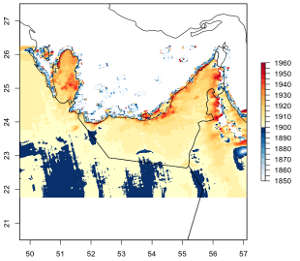Special Issue: Water Narratives
24 December 2025
Published online 31 May 2023
Satellite data was used to assess atmospheric methane concentrations and trends over south-eastern Arabia.

© 2023 Francis, Weston, Fonseca, Temimi and Alsuwaidi
Enlarge image
“In assessments of the region to date, there has been no quantification of methane concentrations,” says Khalifa University atmospheric scientist, Diana Francis.
Francis and her colleagues used high-resolution satellite data to measure atmospheric methane concentrations over the south-eastern Arabian Peninsula, and to assess how they varied from season to season and over the years.
They found that concentrations were low in the colder seasons and high in summer. There was also a generally increasing trend in atmospheric methane, which is many times more powerful a greenhouse gas, contributing to global warming, than the more widely publicised carbon dioxide.
The highest methane concentrations were found in coastal sites, where wet flats called sabkhas and waste landfill sites are found. There were also high concentrations along the Al Hajar mountains, which extend from northern UAE through north-eastern Oman. It is possible that agricultural practices and natural habitats along this mountain range encourage methane-producing microbes.
“Before our work, we had to refer to studies performed elsewhere to infer the trends, but now we can provide proper numbers for this region,” Francis adds. The use of satellite data uniquely provides information on the total amount of methane over a large area, compared to the point data from ground observations used in other regions.
Francis says that the study provides valuable guidance for policymakers trying to develop mitigation strategies to limit the effects of global warming. The study also highlights the need for an extensive ground-based observational network for all greenhouse gasses.
The team next plans to obtain a more comprehensive picture by conducting measurements of carbon dioxide and other greenhouse gases.
“The work is both very interesting and significant,” says atmospheric remote sensing expert Dietrich Feist at the German Aerospace Center, who was not involved in the research. He adds: “Despite being one of the anthropogenic methane hot spot regions in the world, the whole Arabian Peninsula is not covered by the global greenhouse gas monitoring networks.” He therefore encourages the type of follow-up work that the Khalifa team are planning.
doi:10.1038/nmiddleeast.2023.71
Francis, D. et al. Trends and variability in methane concentrations over the South-eastern Arabian Peninsula. Front. Environ. Sci. http://dx.doi.org/10.3389/fenvs.2023.1177877
Stay connected: